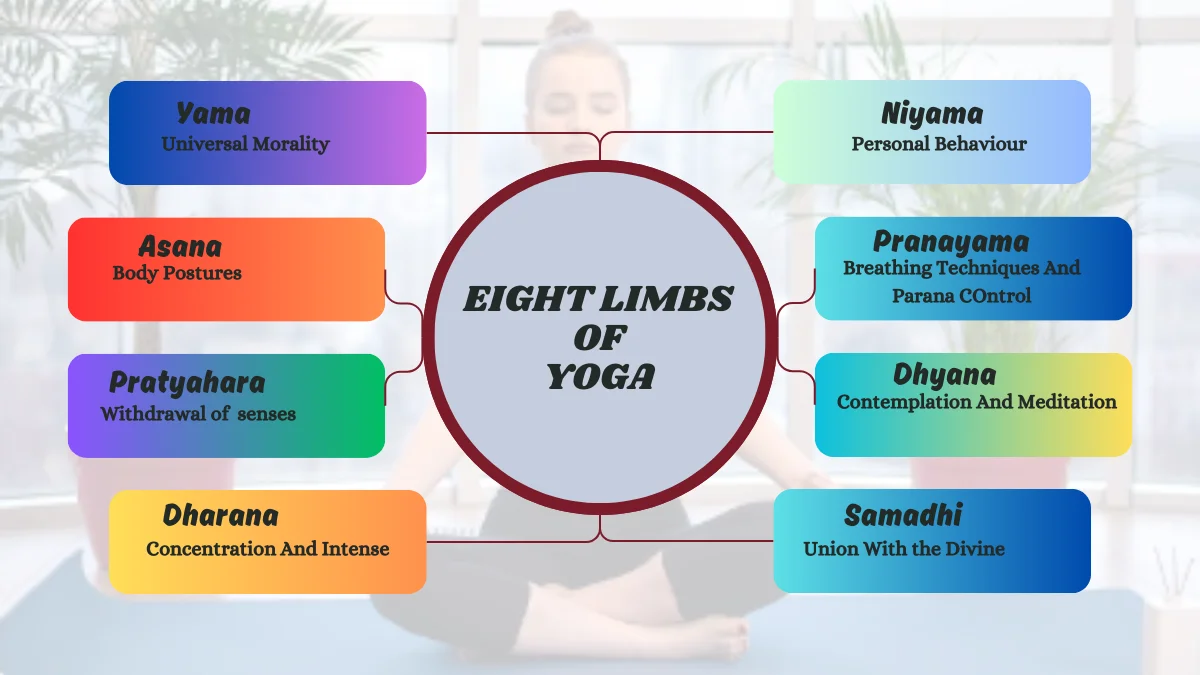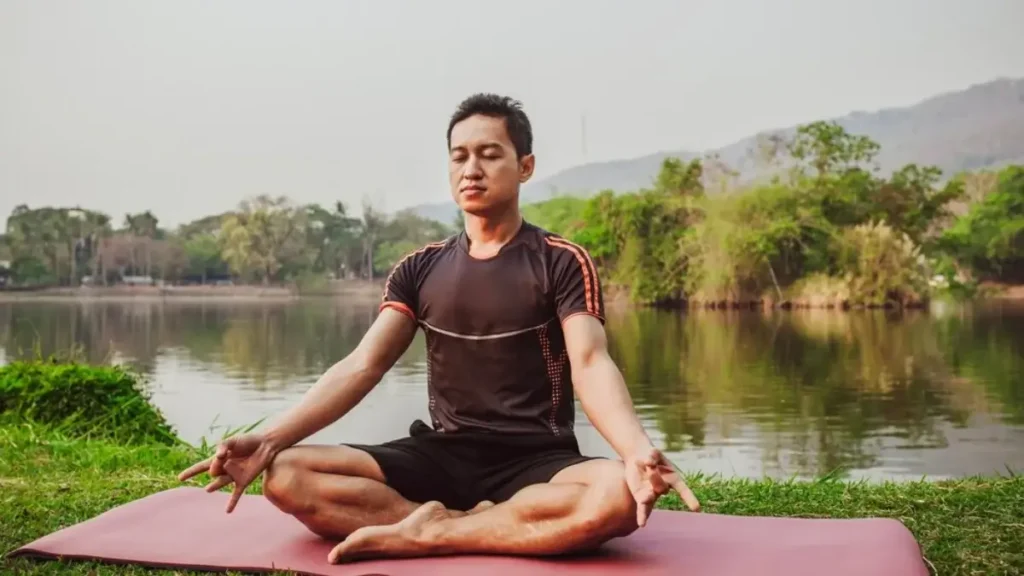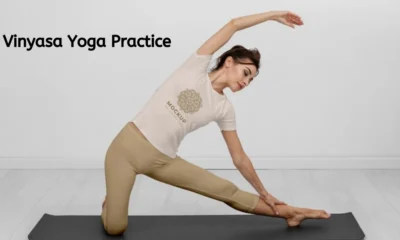YOGA
Exploring the Eight Limbs of Yoga

What is Yoga and its history?
The word “yoga” is derived from the Sanskrit word “yuj,” which means to join or unite. Yoga is more than physical exercise; it is the way to life. An ancient practice spread across a history of more than 5,000 years, it finds its roots in India, where sages first developed it as a way to harmonize body and mind.
Its history and place of origin have nurtured the tradition of yoga into many forms and types, appropriate for the most vivid cultural background and belief; at the same time, they never lost the essence of united elements related to self-awareness and growth to spiritual heights. This basically means that yoga incorporates exercises of breath, meditation, ethical instruction, and practice of postures.
So, with the increase in the number of people visiting Rishikesh, the world came to know about Yoga. It makes no border of culture and becomes a global phenomenon for anyone who is in search of inner peace amid the chaos that modern life has created.
Indeed, millions of people across the globe turn to do Yoga not just because of its physical benefit but mainly because it has the ability to calm the mind and nourish the soul.
Table of Contents
What are the Eight Limbs of Yoga?
The eight limbs of yoga, one of the ancient Indian practices, could be followed by any person willing to live life with a purpose and meaning; they were like stepping stones in the path of self-realization and enlightenment
1-Yama
Yama is the first limb of Yoga, embracing moral principles and ethical guidelines to live. It acts as a bottom for growing personally and harmonizing with society. There are five sub-branches of Yama: Ahimsa (non-violence), Satya (truthfulness), Asteya (non-stealing), Brahmacharya (celibacy or moderation), and Aparigraha (non-possessiveness). It cultivates a way of being with oneself and others to choose kindness over harm in thought, word, and deed.

- Practicing Ahimsa involves cultivating compassion towards oneself and others, promoting kindness over harm in thoughts, words, and actions.
- Satya encourages honesty in communication with oneself and others, fostering trust and authenticity.
- Asteya emphasizes integrity by refraining from taking what is not yours, and respects the possessions of others.
- Brahmacharya advocates for using our energy wisely to maintain balance in all aspects of life.
- Aparigraha implies being non-possessive, allowing no room for greed and attachment to material objects. By upholding such ethical principles, practitioners will be in a position to seek ways to mindful being and thus promote the peaceful milieu in them and their environment.
2-Niyama
Niyama, the second limb of Yoga, focuses on self-discipline and inner observances. It delves into personal ethics and how we interact with ourselves.
- Saucha is the first Niyama—a call toward cleanliness in body and mind. The fact may be that a clean and tidy environment sets conditions for mental alertness.
- Santosha is being happy with whatever one has at any particular moment in life. To be happy with the little that one has is like being happy with everything.
- Tapas means to develop discipline by having self-control and strong determination. It is the commitment to reach our goal even if we are facing lots of difficulties.
- Svadhyaya encourages self-reflection and introspection through study of spiritual texts or personal journals. Understanding oneself leads to growth and enlightenment.
- Ishvara Pranidhana teaches surrendering to a higher power or purpose beyond ourselves. Trusting in something greater can provide solace during difficult times.
3-Asana
Asana, the third limb of yoga, is actually the physical postures taking place in yoga. It is to bring strength, flexibility, and balance to the body. Each of the asanas has its unique set of benefits to the individual’s physical and mental well-being.
From the dog that looks downward to the tree that forms, every asana triggers a different group of muscles and serves as an exercise to control breath and mind. Regular practice of asanas can help one improve his or her posture, relieve stress, and increase overall body awareness.

Whether you are a years’ long practitioner of yoga or a beginner in this part of life’s journey, it has been said that practice of various asanas in everyday practice can evoke your sense of tranquility and rejuvenation. The beauty of the practice of asanas lies in the ability to personalize them according to your own needs and capacity.
So roll out your mat, take a deep breath, and dive into the world of asanas with an open mind and heart.
4-Pranayama
Pranayama is the fourth limb of yoga system, meaning “breath control and regulation.” It is an ancient practice of several breathing exercises specifically intended for calming the mind and energizing the body or for the purpose of controlling and manipulating the breath.
“Nadi Shodhana” is one of the common practices of pranayama, meaning “alternate nostril breathing.” It promotes the balancing of both hemispheres of the brain towards clarity and focus. Another famous exercise is called “Bhastrika” or “bellows breath,” whereby one is said to activate life force energy to cleanse and purify the body from its release.
Regular practice of Pranayama helps one to calm down, decreases the stress level, increases lung function, and focuses. Controlled rhythmic breathing is also very helpful in keeping one down and composed when facing the meditation session.
Incorporating pranayama into your yoga routine can be a powerful tool for achieving holistic health and inner peace.
5-Pratyahara
The fifth limb of Yoga, prajna, is the withdrawal of the senses, developed for self-awareness and inner self-reflection. It nurtures mindfulness and concentration in such a way that it makes the practitioners not swayed by their desires or dislikes. Success in Pratyahara can ultimately pave the way for deep inner transformation and spiritual unfoldment because it provides immense opportunities for mental equilibrium and equipoise. This practice stands like a bridge between the external world and the internal landscape of the thoughts and feelings.
6-Dharana
The sixth aspect in yoga, Dharana, is the practice of concentration: forcing and refocusing one’s mind-roaming, dull awareness on one object or point. During Dharana practices, one learns how to focus attention on a single point or object. It helps in quieting the mind and also prevents distractions from ruining the flow of thoughts.
Dharana is the practice of one-pointedness, facilitating a yogi to increase presence, focus, and introspection. Dharana cultivates the ability to be more resilient against stressors and inner turmoils, which causes better cognitive function, mindfulness, and emotional well-being. In other words, mastering dharana is obtaining a powerful tool not only for gaining inner strength and more presence in all the facets of life but also in further sharpening the focus and gaining more awareness by cutting through most of the mind distractions.
7-Dhyana
The dhyana is the seventh limb of yoga, a practice in meditation. The state of the mind with one-pointedness and concentration. Dhyana helps to quiet the thought-chattering mind and gain access to deeper inner peace and clarity.
Meditation can be done silently, through the help of guided imagery, or even using a mantra. The whole idea here is to be able to find a way one can identify better with themselves and even access their subconscious mind.

One stands to gain with continued practice of Dhyana, reduced stress, increased clarity in thought processes, better self-realization, and general calmness. It helps in manifesting in everyday life by cultivating mindfulness and presence.
Regular meditation helps in growing spiritually and deepening the connecting within. Give yourself the gift of stillness by practicing Dhyana today!
8-Samadhi
Samadhi: the final limb of Yoga—that of enlightenment, merging individual consciousness with the universal consciousness. Brings deep peace, bliss, oneness with all existence. Continuous effort over time with dedicated practice leads one towards achieving Samadhi. It leads to true liberation from suffering, lasting harmony, and leading to deep and profound spiritual growth.
Benefits of Eight Limbs of Yoga
The Eight Limbs of Yoga are beneficial to both the body and the mind. Some benefits that can be obtained as a result of these Eight Limbs include self-discipline, physical strength, flexibility, and control of breath and mental resilience. Techniques in practice help focus on a single point, respectively Pratyahara, Dharana, Dhyana, Concentration, and Meditation. Finally, reaching the state of Samadhi—a state of unity, transcendence, and blissful state—is the ultimate goal. Integrating these principles in practice will naturally lead toward a balanced life.
-

 GENERAL2 months ago
GENERAL2 months agoUncovering the World of кинокрадко: The Dark Side of Film Piracy
-

 GENERAL1 month ago
GENERAL1 month agoUnveiling the Art of преводсч: How Translators Bridge Language Barriers
-

 YOGA1 year ago
YOGA1 year ago4 Person Yoga Poses for Beginners
-

 GENERAL3 weeks ago
GENERAL3 weeks agoChristofle – For Those Who Dream of Family Heirloom Silver





























